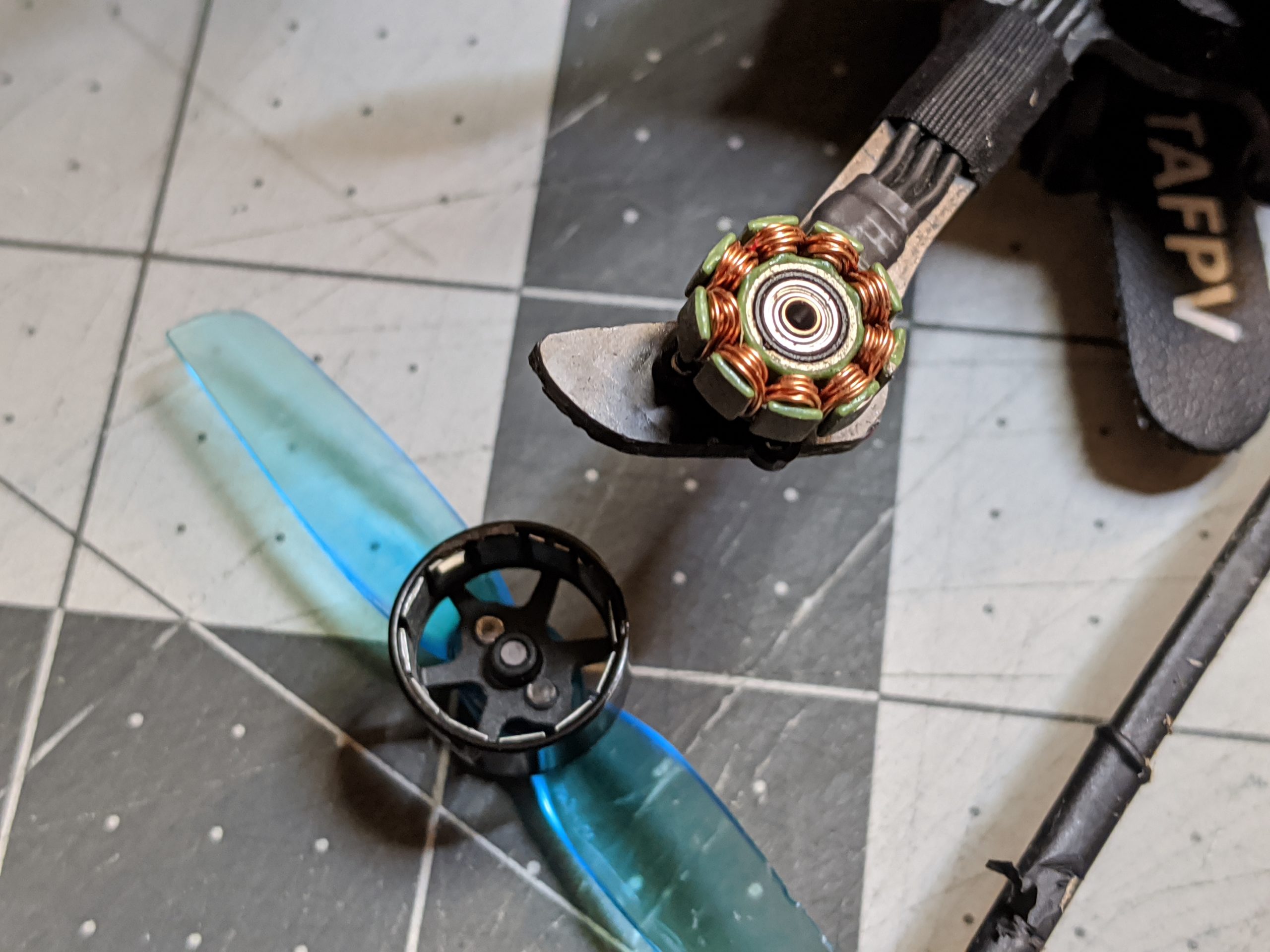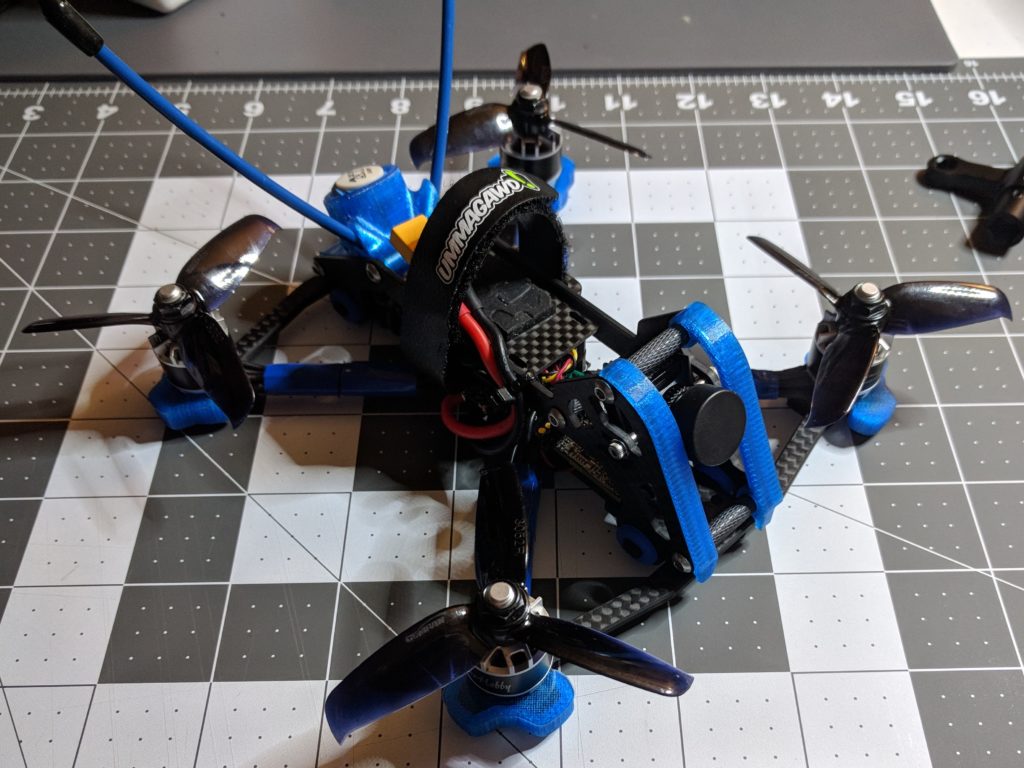
It was decent weather over the weekend for Indiana in December, meaning that it wasn’t completely overcast, windy, and miserable. It was still cold, somewhere in the mid 30’s, but I didn’t want to pass up no wind and a little bit of sun for getting some outside flying in. I charged up half a dozen 2S batteries for my toothpick quad, and a couple of batteries for my boys’ RC cars, and we headed over to their elementary school which is only five minutes away.
I got the boys’ cars setup and they went off to do donuts and ramp off of the playground equipment, while I fired up my radio and goggles and put the first battery in.
It was a little rough getting started. I’m going to blame it on adjusting to the cold. I don’t wear gloves when I fly. I’ve tried it a couple of times and it just messes with my muscle memory too much, even with a thin pair. I had a couple of near misses with trees and playground equipment at first, but by the end of the first battery I was feeling pretty good.
Flying at the school is nice for a couple of reasons. There’s the obvious one that it’s a bigger space with a nice large parking lot so I can keep the throttle more open and really get some speed up as I fly around. There’s also a lot more stuff to play with too. There’s light poles, trees, and playground equipment to fly around and over and through. So it makes it a lot more fun to do proximity flying than what I can do when I go down to the field near my home to fly where I do more loops, flips, and rolls since there aren’t many obstacles.
The second battery started out much better than the first as I was getting familiarized with the space. I made a couple of passes through the playground. I played around with following Thing One’s RC truck as he drove around a couple of trees, and then I took off to make a big looping pass through the playground. I misjudged my line through the obstacles though and pinged of a metal pole. It was a hard hit too as it was enough to cause the flight controller to reboot. I wasn’t worried though, I’ve had hard crashes before with my HX100 and it’s rarely had a problem.
Once the FC came back up, I armed it and tried to take off, but the quad just spun a bit and wouldn’t take off. I disarmed again and took off my goggles and put my radio down to head over. I figured there was some mulch from the playground stuck in a motor or maybe on of the receiver antennas got twisted and was blocking a prop. Both of those things have happened before in a crash, which usually takes a couple of seconds to fix and then I’m back in the air again. This time it was a bit more severe.


This is actually the second time I’ve broken a motor. The last time was in October, so I’m averaging one motor every two months. The October break was some a head-on crash into a heavy tree branch that broke the front right motor. Somehow this time I broke the right rear one. I can’t tell from the video playback, but I must have yawed a little as I hit the pole. It was a pretty hard hit too. I noticed when I got home and inspected the damage that I bent the motor bell and damaged some of the magnets.


I’m not sure if it was just a hard hit against a metal pole, or if the cold had anything to do with it. I feel like I’ve had some equally hard crashes flying my yard, but those collisions usually involve tree branches or wooden fences and not heavy duty playground equipment.
So that put an early end to my flying for the day. It was cold enough out though that my boys didn’t last much longer than that anyway, so I probably wouldn’t have gotten more than another battery in anyway. Just now I have to replace the motor.
It’s not hard to do since I’m using plugs and not direct soldering the motors to the flight controller, it just requires more disassembly than I want to do. I do have to take the canopy off and take the flight controller out because of the tight space that the motor wires and plug run through. I think the last time I did it, it took me a bit more than 20 minutes to do. At least I already have the parts, since these 1103 motors come in sets of four instead of being sold individually, and they’re interchangeable so I don’t need a specific motor at each position.
To be honest, I need to take it apart and do some work on it anyway. The antenna has had a couple of prop strikes on it, and I need to either switch back to some shorter tri-blade props that can’t reach the antenna, or make a change to the canopy so that the antenna stays above the props. I have an idea to drill a small hole through the back of the canopy a few millimeters above where the antenna currently sits so I can feed the antenna out at an angle. That way the canopy itself will keep the antenna from getting down into where the props can hit it.











































